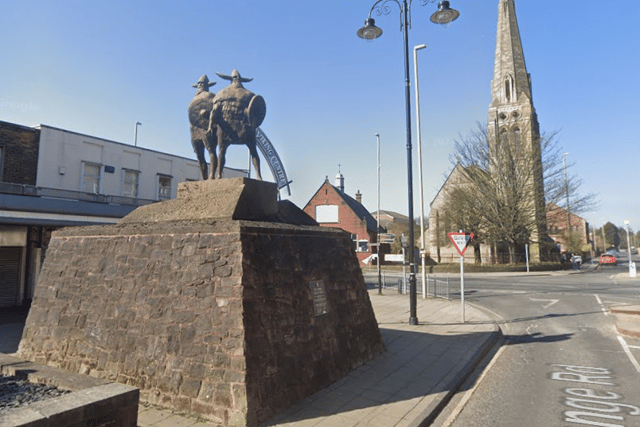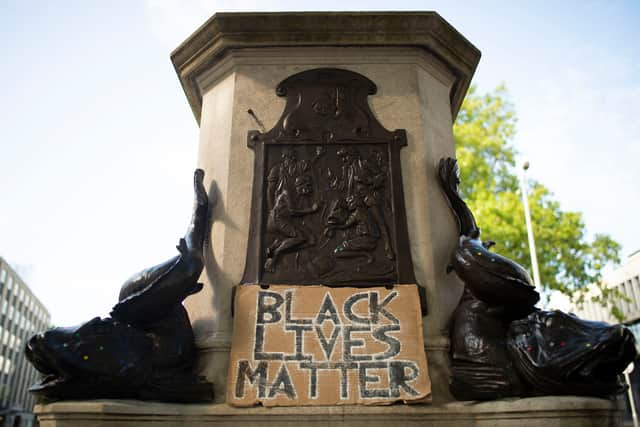What is happening with Jarrow Viking monuments labelled ‘far-right’ after 2020 review re-emerges
and live on Freeview channel 276
A review into the history of South Tyneside monuments completed in 2020 flagged that Viking heritage may be linked to ‘far-right symbolism’ but worries were quashed almost as soon as they were raised.
New findings published by The Telegraph after a Freedom of Information request has made headlines and sparked opinion this week.
Advertisement
Hide AdAdvertisement
Hide AdThe site uncovered documents and decisions that were taken during the review, which ultimately found that there was no need to alter any of the monuments on display in the region.
It has emerged that during the review, Northumbria Police raised potential concerns that the statue of Viking warriors and a shopping centre in Jarrow could have “associations with far-right symbolism and Nordic mythology”.
The statue in question shows two unrealistic soldiers with helmets and shields and was made in the 1960s. It likely references Viking raids on the North East in the Middle Ages.
The statue and nearby The Viking Centre were flagged as amber in the traffic light coding system used by Northumbria Police as a site that may be of concern - the Old Town Hall and Customs House in South Shields received a similar flag due to their connection with race riots in the 1930s.
Advertisement
Hide AdAdvertisement
Hide AdHowever, these findings were reviewed, and the origin of the statue and the name of the shopping centre were deemed not to be a cause for concern.
The Telegraph also quotes David Spender, a former Metropolitan Police officer who now researches crime and policing for Police Exchange, who said that the use of police time on the task “appears to be a bizarre use of police resources”. This concern was also voiced online by some members of the public.
At the time of the review, statues and monuments across the UK and the globe were being vandalised and destroyed in the wake of protests following the murder of George Floyd in the USA which sparked a new wave of the Black Lives Matter movement.


In some of these incidents, counter-demonstrators turned out to protect sites they felt were at risk and police presence was needed. The review into monuments looked to avoid such clashes, which would also have required police time.
Advertisement
Hide AdAdvertisement
Hide AdWhen did the review of South Tyneside’s monuments take place?
A full assessment of the landmarks of South Tyneside was carried out in 2020.
The Shields Gazette reported that the review was launched in June 2020 and had been closed by the end of July of that same year.
At that time a spokeswoman for South Tyneside Council said: “Although we are not aware of any direct links to slavery, together with our partners across the wider North East region, we are reviewing the appropriateness of local monuments and statues on public land and council property.”
What was the result of the review - including the Jarrow Vikings statue?
South Tyneside Council bosses decided that it was not necessary to take any action on the landmarks and statues in the region after the review.
Advertisement
Hide AdAdvertisement
Hide AdA statement from the Council said: “We have carried out a review of council-owned statues and key landmarks and we have not identified any to be inappropriate or particularly controversial.
“As a result of the review, we are not planning to take any further action at this time.”
Why was the review launched in the first place?
The review was launched as a result of the Black Lives Matter movement which gathered pace in 2020 following the murder of George Floyd by Minneapolis police officer Derek Chauvin.


The decision to examine the borough’s public monuments followed a call for all local authorities to do the same after protestors toppled a statue of 17th Century slave trader Edward Colston in Bristol and threw it into the city’s harbour in June 2019.
Advertisement
Hide AdAdvertisement
Hide AdStatues and monuments across the globe had been vandalised, destroyed or removed in the wake of the protests – with counter-demonstrators turning out in some cases to protect sites they felt were at risk.
At the height of the protests, South Tyneside chiefs said they were ‘not aware’ of any links to slavery, but promised to review any statues on public land.
Similar assessments have been carried out by other local authorities in the North East.
Comment Guidelines
National World encourages reader discussion on our stories. User feedback, insights and back-and-forth exchanges add a rich layer of context to reporting. Please review our Community Guidelines before commenting.
